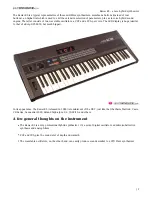
the comparator is now summed with two voltages in U9 (pins 12, 13 &14). One comes from the
+15V supply via R74. The other is the output of the CV summer. The former allows the -15V/0V
output swing of the comparator to be normalised b5V and -5V. The other allows the output
to be offset against zero volts as the pulse width is varied. When the CV summer has zero volts at
its output, the generated pulse waveform is a square wave. No additional offset is added and the
waveform from U9’s output moves b5V and -5V. As the pulse width changes, then the
output of the CV summer moves away from zero. This is added to the waveform and the pulse
output waveform moves above or below zero volts.
Analysing this dynamically changing output reveals that the average output voltage is actually
always zero. This is because the offset added compensates for the altering amounts of time the
waveform spends in the high (or low) states.
The summing circuit also inverts the waveform, so once again, we create the wrong phase. A simple
op-amp inverter circuit, U9 (pins 9, 10 & 11) turns the pulse wave the right way round again.
If you do not want this dynamically varying output signal, then all you need to do is omit R71.
The source of the audio source for the comparator comes from either the triangle or sawtooth
waveforms selectable with a switch on the front panel. This selection is another unique feature of
the Oakley ‘One of three’ VCO. Both will sound the same with fixed pulse widths. But, they do
sound different when the width CV is modulated quickly.
A close up of the exponential convertor of the issue 5 VCO. The THAT300 NPN array is mounted in a 14-pin DIL
socket and the 1K KRL temperature coefficient resistor straddles it. Note the small amount of thermal paste
between the resistor and the array.
10
Summary of Contents for VCO 5U
Page 2: ...2 ...

























